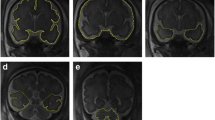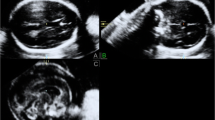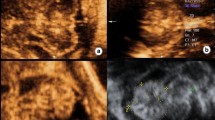Abstract
Fetal magnetic resonance imaging (MRI) is now routinely used to further investigate cerebellar malformations detected with ultrasound. However, the lack of 2D and 3D biometrics in the current literature hinders the detailed characterisation and classification of cerebellar anomalies. The main objectives of this fetal neuroimaging study were to provide normal posterior fossa growth trajectories during the second and third trimesters of pregnancy via semi-automatic segmentation of reconstructed fetal brain MR images and to assess common cerebellar malformations in comparison with the reference data. Using a 1.5-T MRI scanner, 143 MR images were obtained from 79 normal control and 53 fetuses with posterior fossa abnormalities that were grouped according to the severity of diagnosis on visual MRI inspections. All quantifications were performed on volumetric datasets, and supplemental outcome information was collected from the surviving infants. Normal growth trajectories of total brain, cerebellar, vermis, pons and fourth ventricle volumes showed significant correlations with 2D measurements and increased in second-order polynomial trends across gestation (Pearson r, p < 0.05). Comparison of normal controls to five abnormal cerebellum subgroups depicted significant alterations in volumes that could not be detected exclusively with 2D analysis (MANCOVA, p < 0.05). There were 15 terminations of pregnancy, 8 neonatal deaths, and a spectrum of genetic and neurodevelopmental outcomes in the assessed 24 children with cerebellar abnormalities. The given posterior fossa biometrics enhance the delineation of normal and abnormal cerebellar phenotypes on fetal MRI and confirm the advantages of utilizing advanced neuroimaging tools in clinical fetal research.









Similar content being viewed by others
References
Rutherford MA. Magnetic resonance imaging of the fetal brain. Curr Opin Obstet Gyn. 2009;21(2):180–6.
Limperopoulos C, du Plessis AJ. Disorders of cerebellar growth and development. Curr Opin Pediatr. 2006;18(6):621–7.
Triulzi F, Parazzini C, Righini A. Magnetic resonance imaging of fetal cerebellar development. Cerebellum. 2006;5(3):199–205.
Triulzi F, Parazzini C, Righini A. MRI of fetal and neonatal cerebellar development. Semin Fetal Neonat M. 2005;10(5):411–20.
Millen KJ, Gleeson JG. Cerebellar development and disease. Curr Opin Neurobiol. 2008;18(1):12–9.
Sajan SA, Waimey KE, Millen KJ. Novel approaches to studying the genetic basis of cerebellar development. Cerebellum. 2010;9(3):272–83.
Ten Donkelaar HJ, Lammens M. Development of the human cerebellum and its disorders. Clin Perinatol. 2009;36(3):513–30.
Stoodley CJ, Valera EM, Schmahmann JD. Functional topography of the cerebellum for motor and cognitive tasks: an fMRI study. NeuroImage. 2012;59(2):1560–70.
Bolduc ME, Limperopoulos C. Neurodevelopmental outcomes in children with cerebellar malformations: a systematic review. Dev Med Child Neurol. 2009;51(4):256–67.
Mackie S, Shaw P, Lenroot R, Pierson R, Greenstein DK, Nugent TF, et al. Cerebellar development and clinical outcome in attention deficit hyperactivity disorder. Am J Psychiat. 2007;164(4):647–55.
Tavano A, Grasso R, Gagliardi C, Triulzi F, Bresolin N, Fabbro F, et al. Disorders of cognitive and affective development in cerebellar malformations. Brain. 2007;130(Pt 10):2646–60.
Bolduc ME, du Plessis AJ, Sullivan N, Guizard N, Zhang X, Robertson RL, et al. Regional cerebellar volumes predict functional outcome in children with cerebellar malformations. Cerebellum. 2012;11(2):531–42.
Patek KJ, Kline-Fath BM, Hopkin RJ, Pilipenko VV, Crombleholme TM, Spaeth CG. Posterior fossa anomalies diagnosed with fetal MRI: associated anomalies and neurodevelopmental outcomes. Prenatal Diag. 2012;32(1):75–82.
Gandolfi Colleoni G, Contro E, Carletti A, Ghi T, Campobasso G, Rembouskos G, et al. Prenatal diagnosis and outcome of fetal posterior fossa fluid collections. Ultrasound Obst Gyn. 2012;39(6):625–31.
Garel C. Posterior fossa malformations: main features and limits in prenatal diagnosis. Pediatr Radiol. 2010;40(6):1038–45.
Adamsbaum C, Moutard ML, Andre C, Merzoug V, Ferey S, Quere MP, et al. MRI of the fetal posterior fossa. Pediatr Radiol. 2005;35(2):124–40.
Rutherford M, Jiang S, Allsop J, Perkins L, Srinivasan L, Hayat T, et al. MR imaging methods for assessing fetal brain development. Dev Neurobiol. 2008;68(6):700–11.
Tilea B, Alberti C, Adamsbaum C, Armoogum P, Oury JF, Cabrol D, et al. Cerebral biometry in fetal magnetic resonance imaging: new reference data. Ultrasound Obst Gyn. 2009;33(2):173–81.
Vinals F, Munoz M, Naveas R, Shalper J, Giuliano A. The fetal cerebellar vermis: anatomy and biometric assessment using volume contrast imaging in the C-plane (VCI-C). Ultrasound Obst Gyn. 2005;26(6):622–7.
Gholipour A, Estroff JA, Barnewolt CE, Connolly SA, Warfield SK. Fetal brain volumetry through MRI volumetric reconstruction and segmentation. Int J Comput Radiol Surg. 2011;6(3):329–39.
Jiang S, Xue H, Glover A, Rutherford M, Rueckert D, Hajnal JV. MRI of moving subjects using multislice snapshot images with volume reconstruction (SVR): application to fetal, neonatal, and adult brain studies. IEEE T Med Imaging. 2007;26(7):967–80.
Araujo Junior E, Guimaraes Filho HA, Pires CR, Nardozza LM, Moron AF, Mattar R. Validation of fetal cerebellar volume by three-dimensional ultrasonography in Brazilian population. Arch Gynecol Obstet. 2007;275(1):5–11.
Araujo Junior E, Pires CR, Nardozza LM, Filho HA, Moron AF. Correlation of the fetal cerebellar volume with other fetal growth indices by three-dimensional ultrasound. J Matern-Fetal Neo M. 2007;20(8):581–7.
Chang CH, Chang FM, Yu CH, Ko HC, Chen HY. Assessment of fetal cerebellar volume using three-dimensional ultrasound. Ultrasound Med Biol. 2000;26(6):981–8.
Rutten MJ, Pistorius LR, Mulder EJ, Stoutenbeek P, de Vries LS, Visser GH. Fetal cerebellar volume and symmetry on 3-d ultrasound: volume measurement with multiplanar and vocal techniques. Ultrasound Med Biol. 2009;35(8):1284–9.
Clouchoux C, Guizard N, Evans AC, du Plessis AJ, Limperopoulos C. Normative fetal brain growth by quantitative in vivo magnetic resonance imaging. Am J Obstet Gynecol. 2012;206(2):173. e1-8.
Hatab MR, Kamourieh SW, Twickler DM. MR volume of the fetal cerebellum in relation to growth. J Magn Reson Imaging: JMRI. 2008;27(4):840–5.
Scott JA, Habas PA, Kim K, Rajagopalan V, Hamzelou KS, Corbett-Detig JM, et al. Growth trajectories of the human fetal brain tissues estimated from 3D reconstructed in utero MRI. Int J Dev Neurosci. 2011;29(5):529–36.
Malamateniou C, McGuinness AK, Allsop JM, O'Regan DP, Rutherford MA, Hajnal JV. Snapshot inversion recovery: an optimized single-shot T1-weighted inversion-recovery sequence for improved fetal brain anatomic delineation. Radiology. 2011;258(1):229–35.
Yushkevich PA, Piven J, Hazlett HC, Smith RG, Ho S, Gee JC, et al. User-guided 3D active contour segmentation of anatomical structures: significantly improved efficiency and reliability. NeuroImage. 2006;31(3):1116–28.
Royston P, Wright EM. How to construct 'normal ranges' for fetal variables. Ultrasound Obstet Gyn. 1998;11(1):30–8.
Scott JA, Hamzelou KS, Rajagopalan V, Habas PA, Kim K, Barkovich AJ, et al. 3D morphometric analysis of human fetal cerebellar development. Cerebellum. 2012;11(3):761–70.
Grossman R, Hoffman C, Mardor Y, Biegon A. Quantitative MRI measurements of human fetal brain development in utero. NeuroImage. 2006;33(2):463–70.
Limperopoulos C, Tworetzky W, McElhinney DB, Newburger JW, Brown DW, Robertson Jr RL, et al. Brain volume and metabolism in fetuses with congenital heart disease: evaluation with quantitative magnetic resonance imaging and spectroscopy. Circulation. 2010;121(1):26–33.
Garel C, Fallet-Bianco C, Guibaud L. The fetal cerebellum: development and common malformations. J Child Neurol. 2011;26(12):1483–92.
Barkovich AJ, Millen KJ, Dobyns WB. A developmental and genetic classification for midbrain-hindbrain malformations. Brain. 2009;132(Pt 12):3199–230.
Shekdar K. Posterior fossa malformations. Semin Ultrasound CT. 2011;32(3):228–41.
Paladini D, Quarantelli M, Pastore G, Sorrentino M, Sglavo G, Nappi C. Abnormal or delayed development of the posterior membranous area of the brain: anatomy, ultrasound diagnosis, natural history and outcome of Blake's pouch cyst in the fetus. Ultrasound Obstet Gyn. 2012;39(3):279–87.
Kazan-Tannus JF, Dialani V, Kataoka ML, Chiang G, Feldman HA, Brown JS, et al. MR volumetry of brain and CSF in fetuses referred for ventriculomegaly. AJR Am J Roentgenol. 2007;189(1):145–51.
Kyriakopoulou V, Vatansever D, Elkommos S, Dawson S, McGuinnes A, Allsop J et al. Cortical overgrowth in fetuses with hydrocephalus. Cerebral Cortex. 2013. doi:10.1093/cercor/bht062.
Robinson AJ, Blaser S, Toi A, Chitayat D, Halliday W, Pantazi S, et al. The fetal cerebellar vermis: assessment for abnormal development by ultrasonography and magnetic resonance imaging. Ultrasound Q. 2007;23(3):211–23.
Limperopoulos C, Robertson RL, Estroff JA, Barnewolt C, Levine D, Bassan H, et al. Diagnosis of inferior vermian hypoplasia by fetal magnetic resonance imaging: potential pitfalls and neurodevelopmental outcome. Am J Obstet Gynecol. 2006;194(4):1070–6.
Bolduc ME, du Plessis AJ, Evans A, Guizard N, Zhang X, Robertson RL, et al. Cerebellar malformations alter regional cerebral development. Dev Med Child Neurol. 2011;53(12):1128–34.
Bolduc ME, du Plessis AJ, Sullivan N, Khwaja OS, Zhang X, Barnes K, et al. Spectrum of neurodevelopmental disabilities in children with cerebellar malformations. Dev Med Child Neurol. 2011;53(5):409–16.
Habas C, Kamdar N, Nguyen D, Prater K, Beckmann CF, Menon V, et al. Distinct cerebellar contributions to intrinsic connectivity networks. J Neurosci. 2009;29(26):8586–94.
Zimmer EZ, Lowenstein L, Bronshtein M, Goldsher D, Aharon-Peretz J. Clinical significance of isolated mega cisterna magna. Arch Gynecol Obstet. 2007;276(5):487–90.
Forzano F, Mansour S, Ierullo A, Homfray T, Thilaganathan B. Posterior fossa malformation in fetuses: a report of 56 further cases and a review of the literature. Prenatal Diag. 2007;27(6):495–501.
Long A, Moran P, Robson S. Outcome of fetal cerebral posterior fossa anomalies. Prenatal Diag. 2006;26(8):707–10.
Acknowledgments
This study was funded by Biomedical Research Foundation and Medical Research Council, UK. We would like to thank Dr. Ash Ederies, staff at the Robert Steiner MRI Unit, Hammersmith Hospital, London for their support, and all the mothers for their participation in our research.
Conflict of Interest
None of the authors have any conflict of interest to disclose.
Author information
Authors and Affiliations
Corresponding authors
Electronic Supplementary Material
Below is the link to the electronic supplementary material.
ESM 1
(DOC 147 kb)
Rights and permissions
About this article
Cite this article
Vatansever, D., Kyriakopoulou, V., Allsop, J.M. et al. Multidimensional Analysis of Fetal Posterior Fossa in Health and Disease. Cerebellum 12, 632–644 (2013). https://doi.org/10.1007/s12311-013-0470-2
Published:
Issue Date:
DOI: https://doi.org/10.1007/s12311-013-0470-2




